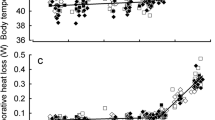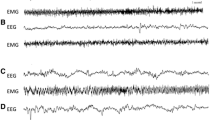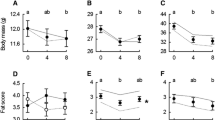Abstract
The heat increment of feeding (HIF), a transient postprandial increase in metabolic rate, is the energy cost of processing a meal. We measured HIF in house wren chicks (Troglodytes aedon) ranging in mass from 1.6 to 10.3 g. This mass range (age 2–10 days) spanned a transition from blind, naked, ectothermic chicks through alert, endothermic birds with nearly complete feathering. We fed chicks crickets (2.7–10% of chick body mass) and determined HIF from continuous measurements of oxygen consumption rate (O2) before and after meals. At warm ambient temperatures (T a) of 33–36 °C, the magnitude of HIF (in ml O2 or joules) was linearly related to meal mass and was not affected by chick mass. HIF accounted for 6.3% of ingested energy, which is within the range of results for other carnivorous vertebrates. The duration of HIF was inversely related to chick mass; 10-g chicks processed a standard meal approximately twice as fast as 2-g chicks. HIF duration increased with increasing meal mass. The peak O2 during HIF, expressed as the factorial increase above resting metabolism, was independent of body mass and meal mass. In large, endothermic chicks ( > 8 g), HIF substituted for thermoregulatory heat production at low T a.
Similar content being viewed by others
Author information
Authors and Affiliations
Additional information
Accepted: 11 December 1996
Rights and permissions
About this article
Cite this article
Chappell, M., Bachman, G. & Hammond, K. The heat increment of feeding in house wren chicks: magnitude, duration, and substitution for thermostatic costs. J Comp Physiol B 167, 313–318 (1997). https://doi.org/10.1007/s003600050079
Issue Date:
DOI: https://doi.org/10.1007/s003600050079




